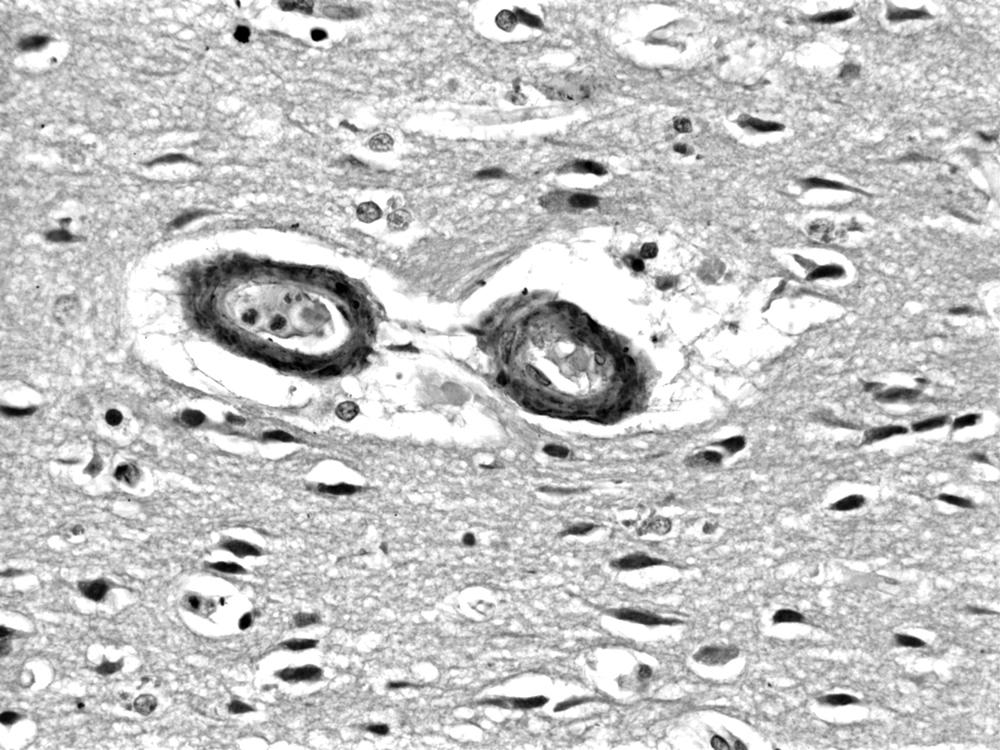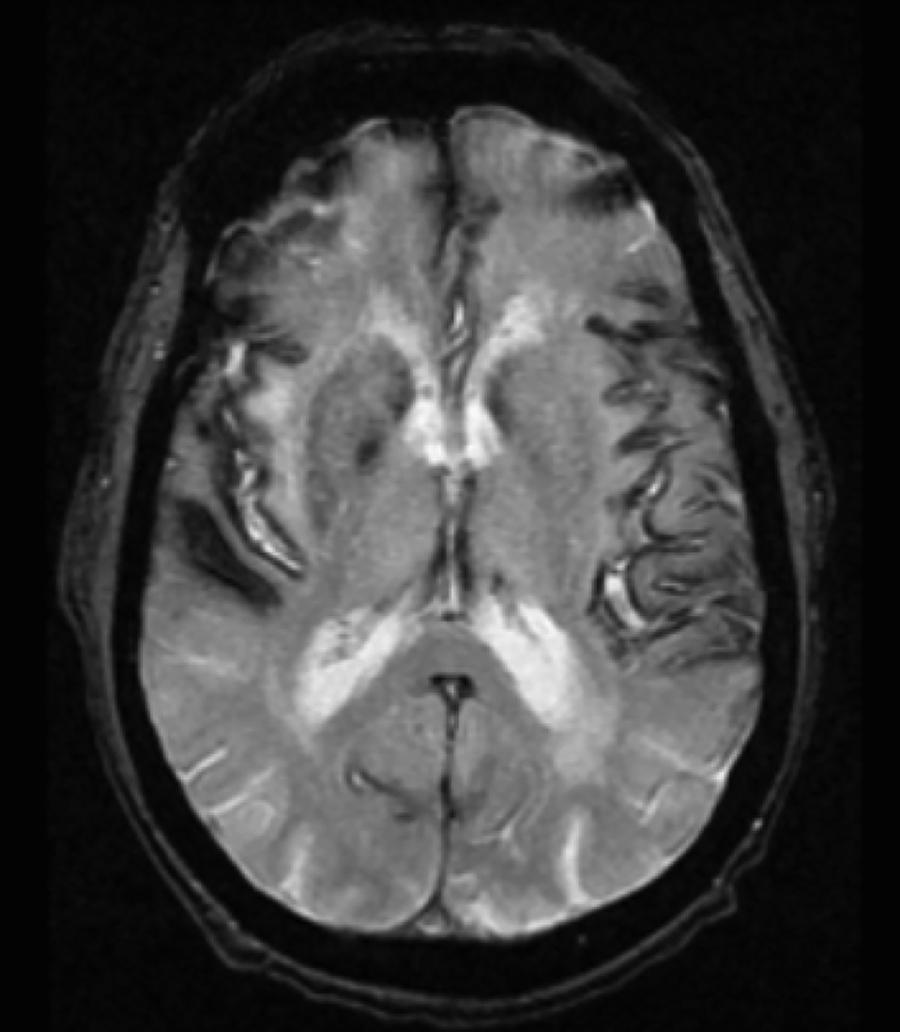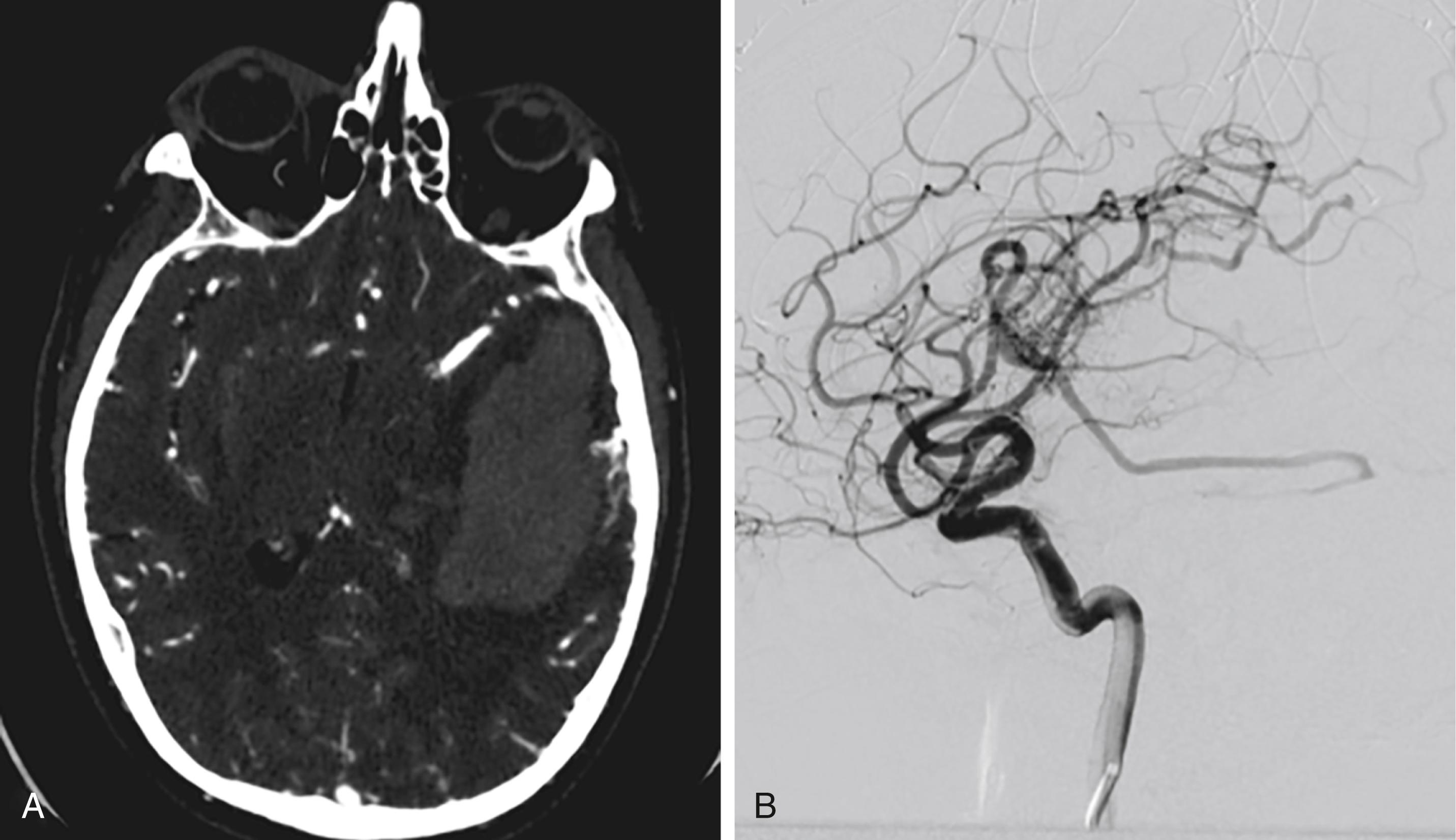Physical Address
304 North Cardinal St.
Dorchester Center, MA 02124
Hemorrhagic infarction, or intracerebral hemorrhages (ICHs), make up approximately 14% of all strokes. Within the United States, ICH occurs with an incidence estimated to range from 15 to 35 cases per 100,000 people per 1 year. Each year, approximately 37,000 to 52,000 people in the United States have an ICH. Unlike ischemic infarctions, for which studies have demonstrated a steady decline over the past two decades, the incidence of ICH has slightly increased. Furthermore, ICH has a higher mortality than ischemic stroke, with only a 51% 3-year survival in ICH patients.
Multiple risk factors for ICH have been identified. The major nonmodifiable risk factors are similar to that of most vascular diseases: age, male sex, hypertension, race, and family history. The incidence of ICH increases significantly after age 55 and doubles with each decade of age until the age of 80, at which point the incidence increases 25-fold each decade. Despite a population-wide stability in the incidence of ICH, there has been a steady increase within the elderly population, thought to be secondary to the increased use of anticoagulants. ICH affects those of Japanese ancestry more than Caucasians, although whether this is secondary to higher incidences of hypertension and/or other socioeconomic factors remains unclear. Regardless, the incidence of ICH among Japanese is 51 per 100,000, approximately twice that of Caucasians. Attention has been drawn to possibly increased incidences among African Americans and Hispanics, yet there remains debate within the literature and this has not been borne out in larger epidemiologic studies. Modifiable risk factors consist of ethanol consumption and, interestingly, low serum cholesterol. Other typical vascular risk factors, smoking and diabetes mellitus, are at best weak risk factors. Finally, multiple studies have previously demonstrated a familial risk for ICH. A portion of this risk is associated with the apolipoprotein (Apo) E 2 or E 4 alleles, which have been demonstrated to confer a higher lifetime risk of ICH. Yet, genome-wide association studies have demonstrated this does not account for all of the risk associated with family history.
There have been numerous case-controlled studies and meta-analyses demonstrating the relationship between hypertension and risk of ICH. The correlation between blood pressure and ICH also leads to diurnal and seasonal variations in the onset of ICH. In general, ICH onset is usually during activity and rarely during sleep, which may be related to elevated blood pressure or increased cerebral blood flow. Similarly, alcohol consumption is a risk factor in both the short term and long term in a dose-dependent fashion. During the 24 hours preceding an ICH, moderate alcohol consumption causes a 4.6 relative risk of ICH, and heavy alcohol consumption (>120 g of ethanol) causes an 11.3 relative risk of ICH. ICH in patients with high ethanol consumption tends to be lobar. Ethanol promotes ICH by impairing coagulation and by directly affecting the integrity of cerebral vessels. Another modifiable variable typically thought of impacting vessel health, cholesterol has been shown to be inversely correlated with a risk for ICH. Iribarren et al. found that for each one–standard deviation increase in serum cholesterol (1.45 mmol/L in men and 1.24 mmol/L in women), there was a relative risk reduction of 0.84 in men and 0.92 in women. One potential mechanism may be that patients with low serum cholesterol may exhibit reduced consumption of animal products, and such patients will have reduced concentrations of arachidonic acid in the cell membranes. Arachidonic acid is a vital structural component of the cell membranes of vascular endothelium, and its metabolites are involved in regulation of vascular tone and repair of injured vascular endothelium. Defects in this pathway may increase the risk of ICH. Conversely, hypercholesterolemia is a proven risk factor for morbidities such as myocardial infarction that are far more common than ICH. Furthermore, patients taking cholesterol-lowering statin drugs before experiencing an ICH have been shown to have lower hematoma volumes.
Typically ICH is classified as either primary or secondary. Primary ICH accounts for nearly 80% of all ICH cases and originates from the spontaneous rupture of small cerebral vessels as a result of small vessel pathology. Secondary ICH occurs in a minority of ICH patients in association with vascular abnormalities, tumors, cerebral infarction, venous sinus thrombosis, or coagulopathies. Although primary ICH in the setting of chronic hypertension remains the most common etiology of ICH, vascular lesions should always be ruled out because of the high risk and mortality associated with recurrent hemorrhage and the necessity of surgical or endovascular treatment to obviate that risk. Computed tomographic angiography (CTA) or magnetic resonance angiography are performed as a screening measure for all patients with ICH and “gold standard” digital subtraction angiography (DSA) performed only for those cases deemed concerning by noninvasive radiologic features and patient characteristics.
In primary ICH, the hemorrhage arises from vessels damaged by chronic hypertension or amyloid angiopathy. Chronic hypertension causes degenerative changes in the walls of small penetrating arteries originating from the anterior or posterior circulations. These changes reduce vessel compliance and increase the likelihood of spontaneous rupture. Patients with chronic hypertension incur an annual risk of recurrent ICH of 2%, but this risk can be reduced by treatment of hypertension. In 1868, Charcot and Bouchard attributed ICH to rupture at points of dilation in the walls of small arterioles that they called microaneurysms. These microaneurysms were later found to be subadventitial hemorrhages or extravascular clots resulting from endothelial damage by the hematoma. Electron microscopy studies have since suggested that most ICHs occur at or near the bifurcation of affected arteries, where prominent degeneration of the media presumably caused by chronic hypertension can be seen.
In amyloid angiopathy, β -amyloid protein, an acellular eosinophilic material, is deposited within the media of small- and medium-sized arteries in the cerebral cortex and leptomeninges, which causes primary ICH in the white matter of the cerebral lobes, particularly the parietal and occipital area. Age is the primary risk factor for this disease, with the majority of patients being older than 70 years and cohort studies demonstrating an increased amount of amyloid in patients as they age. These patients face an annual risk of recurrent hemorrhage of 10.5%. Cerebral amyloid angiopathy is present in the brains of 50% of people older than the age of 70; however, most do not experience ICH. Amyloid angiopathy may be associated with genetic factors including the Apo E allele and may be more prevalent in patients with Down syndrome. O’Donnell et al. reported that the presence of the Apo E 2 or E 4 alleles of the Apo E gene was associated with a tripling of the risk of recurrent ICH among survivors of primary lobar ICH attributable to amyloid angiopathy. Among patients with lobar ICH, those with the Apo E 4 allele typically have their first ICH more than 5 years earlier than noncarriers (average age of 73 versus 79) and experience a statistically independent decrease insurvival. Although they are distinct diseases, there is some overlap between amyloid angiopathy and Alzheimer disease, in that the amyloid in amyloid angiopathy is identical to that found in the senile plaques of Alzheimer disease and Apo E 4 is associated with both the parenchymal plaque amyloid seen in Alzheimer disease and the deposits of β -amyloid protein in cerebral vessel walls seen in amyloid angiopathy. Cerebral amyloid angiopathy may increase the risk of ICH by potentiating plasminogen, a finding that may be of some relevance to patients receiving tissue plasminogen activator (t-PA) to treat ischemic stroke. Definitive diagnosis of amyloid angiopathy is based on the presence of the three following findings: lobar, cortical, or corticosubcortical ICH; severe cerebral amyloid angiopathy on histopathologic exam; and absence of another diagnostic lesion. Histologic findings include deposits of a cellular eosinophilic material in the media of vessels in the hematoma or in noninvolved brain ( Fig. 43.1 ). Microglia, thickened vessel walls, vessel dilatation, and microaneurysms are also seen in the vessels of patients with cerebral amyloid angiopathy. After staining with Congo red, the amyloid in the media of vessel walls exhibits apple-green birefringence under polarized light. However, tissue is not typically obtained in the management of intracranial hemorrhage, so clinical criteria have been developed to suggest the diagnosis of amyloid angiopathy. The Boston criteria establish a means of achieving a diagnosis without tissue. A probable diagnosis occurs with all three of the following findings: age older than 55 years; magnetic resonance imaging (MRI) demonstrating multiple hemorrhages of various ages in the lobar, cortical, or subcortical regions and the presence of superficial siderosis; and absence of another cause of hemorrhage ( Fig. 43.2 ). A diagnosis of possible amyloid angiopathy occurs with age older than 60 combined with either a single lobar, cortical, or corticosubcortical hemorrhage without another cause or multiple hemorrhages with a possible but not a definitive cause.


Secondary ICH is less common than primary ICH. Etiologies include underlying parenchymal, vascular lesions, or coagulopathies. Secondary causes of ICH must be ruled out as a possibility with any ICH. Tumors that produce ICH include both primary central nervous system (CNS) neoplasms and malignant metastases. Hemorrhage is present in 3% to 14% of metastases and is most commonly seen in metastases from renal cell carcinoma, choriocarcinoma, melanoma, and thyroid carcinoma, with hemorrhage occurring in 70%, 50%, 40%, and 25% of the brain metastases from these respective pathologies. However, bronchogenic carcinoma represents the most common source of hemorrhagic cerebral metastases because, although only 9% of metastatic bronchogenic carcinomas hemorrhage, it is a much more common metastatic lesion. Rarely, primary gliomas, both low and high grade, may also present with hemorrhage. When ICH appears on an initial computed tomography (CT) scan, the presence of nonhemorrhagic necrotic or hypodense tissue and pronounced surrounding vasogenic edema are radiologic clues to the underlying neoplasm and warrant an MRI with gadolinium to look for tumor. Vascular malformations that can give rise to secondary ICH are usually arteriovenous malformations (AVMs), with 81% of hemorrhages from AVMs having a significant intraparenchymal component ( Fig. 43.3 ). Cavernous malformations also tend to cause hemorrhage with a significant intraparenchymal component but represent only 10% of CNS vascular malformations. The diagnosis is strongly suggested by finding a mixed signal core indicative of old hemorrhage and a T2 dark rim on an MRI. ICH is unusual from an aneurysmal rupture, which usually causes subarachnoid hemorrhage. Aneurysms that become adherent to the brain surface due to fibrosis from inflammation or previous hemorrhage can sometimes produce ICH rather than subarachnoid hemorrhage when they rupture. Anticoagulant therapy is a known source of secondary ICH. The relative risk of ICH during oral anticoagulant therapy increases more than 10-fold in patients older than the age of 50. Bleeding is more protracted, and hematomas are larger in patients treated with anticoagulants than in those with spontaneous ICH. The management of these patients requires rapid reversal of their coagulopathy, which has become slightly more complex in recent years secondary to the advent of novel oral anticoagulants (NOACs).

Edematous parenchyma, often discolored by degradation products of hemoglobin, is visible adjacent to the clot and correlates with areas of CT and MRI T1 hypodensity and MRI T2 hyperdensity. Histologic sections are characterized by edema, neuronal damage, macrophages, and neutrophils in the region surrounding the hematoma. The hemorrhage spreads between planes of white matter, causing varying degrees of tissue destruction, leaving nests of intact neural tissue within and surrounding the hematoma. This pattern of spread accounts for the presence of viable and salvageable neural tissue in the immediate vicinity of the hematoma.
The presence of hematoma initiates edema and neuronal damage in the surrounding parenchyma. Animal models of ICH have identified three phases of perihematoma edema: immediate (within 24 hours), intermediate (24 hours to 5 days), and late onset (from 5 days to several weeks after ICH). Immediate edema occurs within the first 24 hours and can often be seen at a histologic but not radiographic level. This initial edema develops secondary to osmotically active plasma proteins accumulating in the extravascular space. The blood-brain barrier is intact at this point, so the proteins most likely arise from the hematoma. After the initial hemorrhage, the clotting cascade activates thrombin, which disrupts the blood-brain barrier and activates the complement cascade, leading to lysis of red blood cells and other bystander cells. Vasogenic edema and cytotoxic edema subsequently follow owing to the disruption of the blood-brain barrier, the failure of the sodium pump, and the death of neurons. This represents the intermediate edema seen at 24 hours to 5 days. This intermediate edema is noticeable radiographically and histologically. Red blood cell lysis releases hemoglobin and leads to formation of free radicals, which account for the late-onset edema. The role of the coagulation cascade in intermediate perihematoma edema may explain why ICH related to thrombolysis or coagulopathy causes less perihematoma edema than spontaneous ICH.
Studies in animals and humans have refuted the notion that cerebral ischemia in areas of ICH occurs due to mechanical compression by the hematoma and have suggested that secondary mediators may cause the delayed development of neuronal injury adjacent to a hematoma. It is currently thought that blood products mediate most secondary processes initiated after ICH. Evidence has suggested the presence of apoptosis in neurons adjacent to ICH associated with nuclear factor-κB expression in neuronal nuclei. Other studies have suggested that heme derived from erythrocytes extravasated during ICH is degraded into bilirubin and bilirubin oxidation products, which activate microglia, which secrete cytokines that recruit leukocytes into the brain, which contribute to the injury process.
The anatomic location of an ICH can often lend insight to the underlying etiology of the hemorrhage. ICH commonly occurs in the cerebral white matter (10% to 20%); basal ganglia/internal capsule (50%); thalamus (15%); the pons (10% to 15%); other brain stem sites (1-6%); and cerebellum (10%). Common arterial feeders of ICHs are the lenticulostriate branches of the anterior and middle cerebral arteries which form Charcot-Bouchard microaneurysms and are the source of putaminal ICH; thalamoperforators branching off the anterior and middle cerebral arteries which are the source of thalamic ICH; and paramedian branches of the basilar artery, which are the source of pontine and cerebellar ICH.
ICH into the cerebral white matter includes ICH into the occipital, temporal, frontal, and parietal lobes, including ICH arising from the cortex and subcortical white matter, as opposed to ICH of deep structures such as the basal ganglia, thalamus, and infratentorial structures. Frontal lobe ICH causes frontal headache with contralateral hemiparesis, usually in the arm, with mild leg and facial weakness. Parietal lobe ICH causes contralateral hemisensory deficit with mild hemiparesis. Occipital lobe ICH causes ipsilateral eye pain and contralateral homonymous hemianopsia, with some sparing of the superior quadrant. Temporal lobe ICH can be asymptomatic on the nondominant side but, on the dominant side, produces fluent dysphasia with poor auditory comprehension but relatively good repetition. Lobar ICH in younger patients is more likely to be associated with structural abnormalities such as AVMs or tumors than deep hemorrhages. Lobar ICH is also more common in patients with alcohol consumption. Patients older than 55 are more likely to have amyloid angiopathy as their underlying pathology. Significant independent risk factors for lobar ICH include the presence of an Apo E 2 or E 4 allele, frequent alcohol use, prior stroke, and first-degree relative with ICH, and significant independent risk factors for nonlobar ICH were hypertension, prior stroke, and first-degree relative with ICH.
In putaminal ICH, 62% of patients experience smooth gradual deterioration, with only 30% exhibiting their maximal deficit at the onset. In some studies, the 30-day mortality rate has been 50%. The clinical presentation of putaminal hemorrhage may vary from relatively minor pure motor hemiparesis to profound weakness, sensory loss, eye deviation, hemianopsia, aphasia, and depressed level of consciousness. Headache is a presenting symptom in only 14% of putaminal ICHs. In putaminal ICH, intraventricular extension portends a poor prognosis, because the hematoma must be quite large to track through the internal capsule and reach the ventricle.
Thalamic ICH usually causes contralateral hemisensory loss out of proportion to any weakness. Hemiparesis can ensue when the internal capsule becomes involved. Extension into the midbrain can cause vertical gaze palsy, retraction nystagmus, skew deviation, loss of convergence, ptosis, miosis, and anisocoria. Nearly 30% of patients with thalamic ICH present with headache. Hydrocephalus may result from obstruction of cerebrospinal fluid reabsorption pathways. In a series of 41 patients with thalamic ICH, all with hemorrhage diameter greater than 3.3 cm on CT died, with smaller hematomas causing permanent disability. Patients with supratentorial ICH involving the putamen, caudate, or thalamus have contralateral sensory-motor deficits of varying severity due to involvement of the internal capsule. Higher-level cortical dysfunction, including neglect, gaze deviation, hemianopsia, and, for dominant hemisphere lesions, aphasia, can occur as a result of disruption of connecting fibers in the subcortical white matter and functional suppression of overlying cortex, known as diaschisis.
Become a Clinical Tree membership for Full access and enjoy Unlimited articles
If you are a member. Log in here